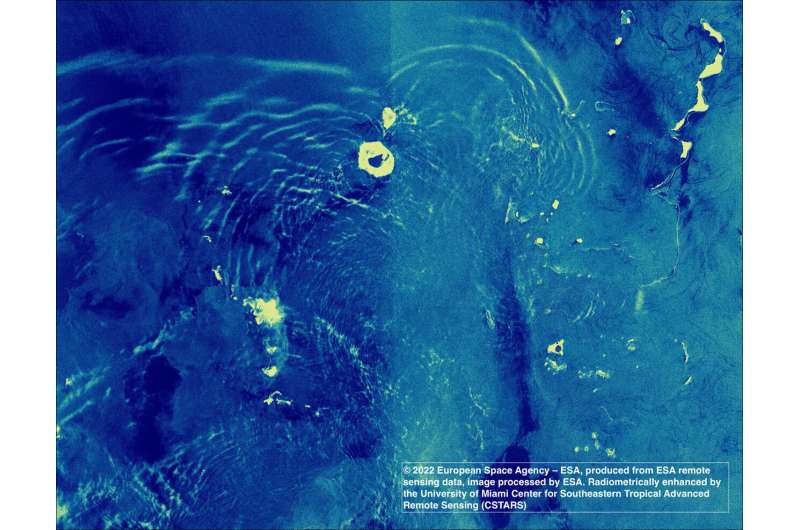2022 Tongan volcanic eruption was largest natural explosion in more than a century, new study finds

The 2022 eruption of a submarine volcano in Tonga was more powerful than the largest U.S. nuclear explosion, according to a new study led by scientists at the University of Miami Rosenstiel School of Marine, Atmospheric, and Earth Science and the Khaled bin Sultan Living Oceans Foundation.
The 15-megaton volcanic explosion from Hunga Tonga-Hunga Ha’apai, one of the largest natural explosions in more than a century, generated a mega-tsunami with waves up to 45 meters high (148 feet) along the coast of Tonga’s Tofua Island and waves up to 17 meters (56 feet) on Tongatapu, the country’s most populated island.
In a new analysis in Science Advances, Rosenstiel School researchers used a combination of before-and-after satellite imagery, drone mapping, and field observations collected by scientists at the University of Auckland, and data from the Khaled bin Sultan Living Oceans Foundation Global Reef Expedition, to produce a tsunami simulation of the Tongan Archipelago. The results showed how the complex shallow bathymetry in the region acted as a low-velocity wave trap, capturing a more than hour-long tsunami with waves up to 85 meters (279 feet) high one minute after the initial explosion.
The submarine volcanic eruption of Hunga Tonga-Hunga Ha’apai, which forms the island chain of Tonga and is a result of the convergence of the Pacific and Indo-Australian tectonic plates, rivaled the 1883 eruption of Krakatau that killed more than 36,000 people.
“Despite its size and long duration, the mega-tsumani that resulted from Hunga Tonga-Hunga Ha’apai claimed few lives,” said Sam Purkis, professor and chair of the Department of Marine Geosciences at the Rosenstiel School. “The main factors that led to this, we suggest, are the quirk of the location, the COVID-19 pandemic, and increased evacuation drills and awareness efforts carried out in Tonga in the years prior to the eruption.”
The simulation also suggested that the eruption location relative to urban centers saved Tonga from a worse outcome.
“While 2022 may have been a lucky escape, other submarine volcanoes possess the capacity to spawn a future tsunami at the same scale,” said Purkis, who is also chief scientist at the Khaled bin Sultan Living Oceans Foundation.
“This eruption holds important lessons for both past and future tsunami in Tonga and beyond. The eruption was an excellent natural laboratory to test hypotheses and models that can be deployed elsewhere to improve future disaster preparations, and better understand similar eruptions and subsequent tsunami as preserved in antiquity and in the geologic record.”
More information:
Sam Purkis, The 2022 Hunga-Tonga Mega-tsunami: Near-Field Simulation of a Once-in-a-Century Event, Science Advances (2023). DOI: 10.1126/sciadv.adf5493. www.science.org/doi/10.1126/sciadv.adf5493
Citation:
2022 Tongan volcanic eruption was largest natural explosion in more than a century, new study finds (2023, April 14)
retrieved 14 April 2023
from https://phys.org/news/2023-04-tongan-volcanic-eruption-largest-natural.html
This document is subject to copyright. Apart from any fair dealing for the purpose of private study or research, no
part may be reproduced without the written permission. The content is provided for information purposes only.
For all the latest Science News Click Here
For the latest news and updates, follow us on Google News.

